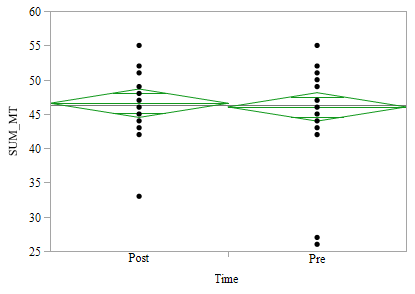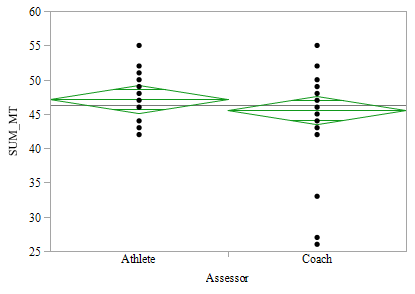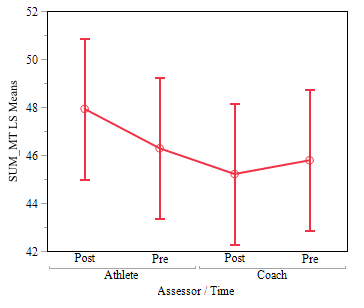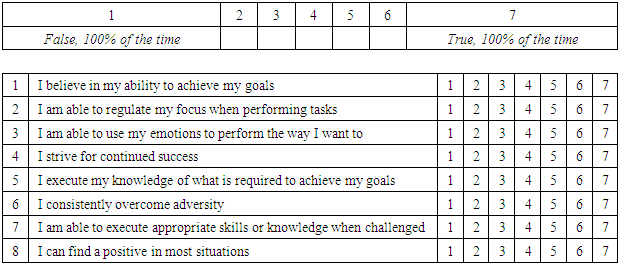-
Paper Information
- Paper Submission
-
Journal Information
- About This Journal
- Editorial Board
- Current Issue
- Archive
- Author Guidelines
- Contact Us
International Journal of Sports Science
p-ISSN: 2169-8759 e-ISSN: 2169-8791
2018; 8(5): 152-157
doi:10.5923/j.sports.20180805.03

What a Difference a Mentally-Toughening Off-Season Makes: A Case of NCAA DI Rowers
Andreas Stamatis1, Zacharias Papadakis2
1Department of Sport and Wellness, State University of New York at Plattsburgh, NY, U.S.A.
2Department of Sport and Exercise Sciences, College of Nursing and Health Sciences, Barry University, FL, U.S.A.
Correspondence to: Andreas Stamatis, Department of Sport and Wellness, State University of New York at Plattsburgh, NY, U.S.A..
| Email: |  |
Copyright © 2018 The Author(s). Published by Scientific & Academic Publishing.
This work is licensed under the Creative Commons Attribution International License (CC BY).
http://creativecommons.org/licenses/by/4.0/

Non-contact injuries in US collegiate athletics during offseason have increased. Despite the widespread acceptance of mental toughness (MT) training in the strength and conditioning world, coaches do not tend to measure the effectiveness of their regimens. Strength and conditioning coaches (SCC) tend to design mostly physical and not psychological protocols to increase MT. Purpose: Triggered by current incidents in Big 12, in Pac-12, and most recently, in Big Ten -in which SCCs were purportedly involved, researchers attempted to investigate the effectiveness of an offseason physical training protocol on the MT levels of Division I rowers. Methods: Fourteen student-athletes and their strength and conditioning coach (multi-rating) assessed, via Qualtrics, the players’ levels of MT using the Mental Toughness Index (MTI). Results: No statistically-significant effect was found between pre- and post-offseason intervention [F (1, 54) = 0.13, p = 0.71] nor between the perception of that effect between players and coach [F (1, 54) = 1.23, p = 0.27]. Conclusions: The levels of athletes’ MT between the pre- and post-intervention measurements did not increase significantly and the perceptions of the assessors were not significantly different either. Therefore, the results suggest that the intervention did not work in regard to increasing the MT levels of the team. Furthermore, the MTI scores indicate coach-athlete compatibility in recognizing this theoretical construct. In an effort to support the student-athletes’ well-being and avoid similar media backlash, more similar research projects are crucial so as to move from anecdotally-based to evidence-based strength and conditioning MT training protocols. However, during that attempt, coaches need to share their protocols for reasons of evaluation and replication.
Keywords: Multi-rating, Mentally tough, Rowing, Collegiate athletics, Female student-athlete, Mental toughness, Applied sport psychology, Strength and conditioning
Cite this paper: Andreas Stamatis, Zacharias Papadakis, What a Difference a Mentally-Toughening Off-Season Makes: A Case of NCAA DI Rowers, International Journal of Sports Science, Vol. 8 No. 5, 2018, pp. 152-157. doi: 10.5923/j.sports.20180805.03.
Article Outline
1. Introduction
- “The CSCCa extends its deepest sympathy to the family of University of Maryland offensive lineman Jordan McNair. Furthermore, we are extremely distressed by the media reports regarding the culture of the Maryland Football Program, especially the alleged involvement of the strength and conditioning program. Every athlete deserves a positive, constructive environment in which to work and train to develop his/her full athletic potential safely and effectively…” [10]The popularity of the term mental toughness (MT) in scholarly but also in non-scholarly (i.e., practice) sport settings in the past two decades is well recognized [16]. In addition, even if there is no consensus on its exact definition (e.g., [3, 16, 25]), MT’s worldwide cultural relevance, even in non-English-speaking countries, has started being uncovered (e.g., [21, 29]). However, incidents, such as the ones in Big 12 [5], in Pac-12 [23], and most recently, in Big Ten [34] have once again raised concerns in the U.S. strength and conditioning community (see example of statement above). These concerns focus on the safety and effectiveness of anecdotally-based, military-style, strength and conditioning protocols usually occurring in the offseason and designed to challenge student-athletes’ psychological attributes, such as MT.A review of the literature uncovers that the majority of MT research is mainly correlational [42]. For example, MT has been correlated with positive mental health outcomes (e.g., stress, depression; sleep quality; [9, 14, 30]), as well as recognized predictors of performance (e.g., motivation, self-efficacy; [15, 35]). Moreover, in the limited interventional MT research, the prescribed protocols are mainly psychological and not physical (e.g., [1, 6, 7, 17, 18, 27, 36, 38, 40]). Nevertheless, SCCs prescribe mainly physical training protocols [33].Preliminary data have indicated that collegiate SCCs are not aware of the existence of specific psychometric tools and/or do not use any to measure the effect of their interventions on the MT levels of their athletes (e.g., [43]). So, how do SCCs know if they prescribe safe and effective offseason MT training protocols (dose-response relationship; [2])? This study focuses on the effectiveness of such an offseason training regimen in a National Collegiate Athletics Association (NCAA) Division I (DI) rowing team.Among other groups, female athletes remain underrepresented in applied Sport Psychology research [45]. Rowing is the oldest intercollegiate sport in the United States [46]. However, NCAA sanctions women’s rowing, but not men’s. Rowing, along with softball, bowling, and beach volleyball is played by female student-athletes only in DI NCAA. Rowing is a spring sport, which –as shown in Table 1– has presented noteworthy progress [32]. Nonetheless, it has not been researched as much.
|
2. Method
2.1. Experimental Approach to the Problem
- The study followed a quasi-experimental, one-group pretest-posttest model. The research problem was suited for this kind of design, since the intervention was performed to all active athletes (i.e., no control group). Data were collected using an instrument (i.e., MTI). However, multi-rating was performed (i.e., player, strength coach).
2.2. Participants
- The rowers of a DI NCAA institution were the target population (i.e., inclusion criteria). All participants were part of the same team (criterion-based purposive sample). All players were contacted. Thus, there was no random selection of participants. Fourteen rowers agreed to participate (Mage=20.36, SD=1.01).
2.3. Instrument
- Data collection was performed though the Mental Toughness Index (MTI; [32]). MTI is a self-report MT measure and includes eight items (see Appendix). MTI’s scores were found to be reliable and the inferences of those scores valid [11, 20, 24]. Gucciardi et al. conceptualize MT1 as one-dimensional and as a caravan of personal resources [20]. Based on that, each item (i.e., question) of MTI is designed to correspond to each one of those resources. In more detail, item 1 measures generalized self-efficacy, item 2 emotion regulation, item 3 attention regulation, item 4 success mindset, item 5 buoyancy, item 6 overcoming adversity, item 7 context knowledge, and item 8 optimistic style.
2.4. Procedures
- After the Institutional Review Board (IRB) approval, the survey was uploaded on Qualtrics (www.qualtrics.com). After the Athletic Department shared the players’ email addresses, all rowers received individualized links. The participants were then able to go online and complete the survey. The procedure was performed twice, before and after offseason. This specific phase of periodization was chosen since it is the only period of the year, when DI SCCs are almost fully in charge of the training. Consequently, in that phase of training the researchers could control for more extraneous variables.Due to established (a) limitations of self-reporting (e.g., under/overstimation of perception; [13]) and (b) implications of perception (perception-action coupling; [22]), the players were rated by their SCC, as well. Multi-rating was chosen in order to promote triangulation of the scores. Although triangulation enhances the validation of the data through cross-verification from multiple sources, a very limited number of MT researchers have used it and/or have looked for discrepancies in perceptions of different assessors (e.g., [12, 17, 18, 40, 47]).
2.5. Statistical Analyses
- The researchers were interested in examining (a) the effect of MT training protocols on DI rowers and (b) possible differences in the perception of that intervention effect between athletes and coach. Total MT scores were calculated by adding the scores per item (range of scores per item: from one to seven). As mentioned before, MTI consists of eight items. As a result, total MT scores could range from eight to 56. A one-way ANOVA was used to examine pre-intervention and post-intervention levels of athletes’ MT. A one-way factorial ANOVA design was used to assess the coach’s and student-athletes’ responses on MTI between pre- and post-intervention. All statistical analyses were performed using JMP (Pro 14.0) [37].
3. Results
- The summary statistics are presented in Table 2 (Mscore=40.30, SD=5.43). The results represent both the two self-assessments from the 14 athletes (n=28) and the two assessments of the athletes from the SCC (n=28). Therefore, the total number of measurements considered is 56.
|
3.1. Did the Intervention Work?
- As shown in Table 3 and Figure 1, on average, MT levels increased post intervention. However, no statistical significance was found between pre- and post-values: F (1, 54) = 0.13, p = 0.71. Therefore, the first hypothesis is rejected.
 | Figure 1. One-way ANOVA means for pre- and post-intervention athletes’ MT levels |
|
3.2. Did Athletes and Coach have Different Perceptions on the Effect of the Intervention (over time)?
- As shown in Table 4 and Figure 2, there is a pattern of student-athletes perceiving the effect of the intervention as more substantial compared to the SCC. However, no statistical difference was observed: F (1, 54) = 1.23, p = 0.27. Therefore, the second hypothesis is rejected.
|
 | Figure 2. One-way ANOVA means for athletes' and coach's perceptions on effect of offseason intervention on athletes’ MT levels |
 | Figure 3. Least square means plot for athlete/coach and pre/post perceptions on effect of offseason intervention on athletes’ MT levels |
4. Conclusions
- The purpose of this study was to investigate, using a quasi-experimental design, the effect of an offseason physical strength and conditioning training protocol on the levels of MT of a team of NCAA DI rowers, while examining possible differences in the perception of that effect between athletes and coach. Data were collected from 14 student-athletes and their SCC through an inventory, MTI.The levels of athletes’ MT between the pre- and post-intervention measurements did not increase significantly and the perceptions of the assessors were not significantly different either. Therefore, both hypotheses were rejected.In other words, despite the initial prediction of the SCC, in our case, the intervention did not work in regard to increasing the MT levels of the team. Unexpectedly, too, the results may indicate coach-athlete compatibility in recognizing this theoretical construct.
4.1. Limitations and Delimitations
- This research is not immune to limitations or delimitations. Therefore, the inferences of the results should be interpreted and generalized with caution. In more detail:(A) Although the inclusion and exclusion criteria were well established and there were no missing data, not all eligible participants were enrolled. That affects the extrapolation of the inferences of the results negatively;(B) The coach indicated that the same intervention was consistently applied to the participants. He did not agree to clearly describe it though. Therefore, sufficient details to allow the work to be reproduced by an independent researcher cannot be provided;(C) The outcome measure was clearly defined, MTI is a psychometrically-sound instrument, and assessment from the coach was included to increase validity of the inferences of the results. Nevertheless, the person prescribing and applying the intervention (i.e., the strength coach) was the same person conducting the outcome assessment. No blinding of outcome assessors raises questions about possible bias; and(D) While the reported study results documented the (lack of) statistical significance for the changes in MT levels, the dependent variable was not measured more than once before and after offseason. The absence of multiple measurements with the same result decreases the confidence on the inferences of the results of this study.
4.2. Future Research
- While this research project focused on DI rowing, more research is recommended in the other two NCAA divisions as well in other DI rowing programs. Most importantly, although the authors tried to enhance the validation of the data including the SCC as an assessor, due to possible bias, another source could lead towards a more efficient triangulation. For instance, Cowden, Anshel, and Fuller (2014) chose to use the sport coach. However, during offseason and due to NCAA regulations and restrictions, the sport coach may not be able to accurately assess their players. A possible better choice could be the head SCC who could design the protocol, but that protocol would be implemented by somebody else, such as an assistant SCC.Furthermore, based on the needs of coach, the analysis of the data can be performed by: (a) athlete (i.e., “Who has the highest/lowest total MT score”), (b) by question (e.g., “Which MT resource is the team’s strength or weakness?”), (c) years in the program (e.g., “On average, how much time does it take for the ‘MT culture’ of the program to significantly affect the athlete’s MT levels?”), and (c) other demographics (e.g., position, race, gender).
4.3. Practical Implications
- The National Strength and Conditioning Association (NSCA) and the Collegiate Strength and Conditioning Coaches association (CSCCa), the two leading authorities in the US collegiate strength and conditioning field, have both endorsed “The Inter-Association Task force for Preventing Sudden Death in Collegiate Conditioning Sessions: Best-Practices Recommendations” [39, 44]. In addition, the majority of National Collegiate Athletic Association Autonomous 5 Division I (A5DI) institutions have implemented more rigorous cardiovascular screening than just history and physical [28].The exact cause of the University of Maryland event is likely multifactorial. Unfortunately though, analogous incidents will most likely happen again, since there are factors, such as primordial, which are difficult to detect or avert [2].
4.3.1. What can SCCs do to Prescribe Safe and Effective Protocols?
- There are 6,000 teams and 170,000 student-athletes in DI programs [31]. How can the SCC, who spends the most “countable hours” with student-athletes compared to other coaches (i.e., NCAA Bylaw 17), ensure that their protocols are safer and more effective?Although it may not always be practical to conduct research with control groups in DI institutions and metric arbitrariness is usually a concern when using inventories [4, 8], just “body language” should not be enough anymore [43], if the profession wants to attack the lack of empirically-based practices [19].As shown above, MT has been consistently correlated with performance predictors. The method to develop it though through safe and effective physical protocols remains vague. At the same time, there are (a) official positions from the professional organizations of the field to move towards evidence-based practices (e.g., [26]) and (b) preliminary evidence through published [43] and unpublished data [41] that verify that SCCs ask for research that measures the effectiveness of their training protocols. Therefore, there has to be an intentional and collective effort from the practitioners themselves to not only keep participating in similar research projects, but also to share their protocols. By sharing, other professionals could draw conclusions, evaluate and adjust their regiments, and in the end, the field of strength and conditioning could shift away from anecdotally-based practices and the negative issues related to them.
Appendix
- Mental Toughness IndexINSTRUCTIONS: Using the scale below, please indicate how true each of the following statements is an indication of how you typically think, feel, and behave as an athlete.Remember: There are no right or wrong answers. So, be as honest as possible.

Note
- 1. “…a personal capacity to produce consistently high levels of subjective (e.g., personal goals or strivings) or objective performance (e.g., sales, race time, GPA) despite everyday challenges and stressors as well as significant adversities.” (20, p. 31).
 Abstract
Abstract Reference
Reference Full-Text PDF
Full-Text PDF Full-text HTML
Full-text HTML


